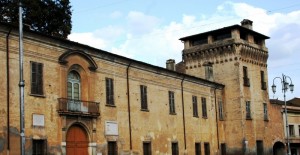Palazzo Gonzaga-Acerbi
Palazzo Gonzaga-Acerbi is located in the main square of the village occupying an entire side, the first to inhabit it were the Gonzagas in the fifteenth century.
Palazzo Gonzaga-Acerbi originally was composed of two separate buildings; one occupied by the municipality (domus civis), the other occupied by the vicar of the Gonzaga il Torrazzo. In 1480 Ludovico Gonzaga, bishop of Mantua, did some renovations on the building, perhaps combining the two buildings. The construction of the new Palazzo della Ragione or the Comune of Castel Goffredo seems to have been in that period; however, from 1511 the renovated palace became the residence of the Marquis Aloisio Gonzaga who further embellished it and hosted illustrious personalities such as: the imperial captain Luigi Gonzaga Rodomonte, the poet Pietro Aretino, the writer Matteo Brandello, friar Patrizio Tricasso, the emperor Charles V in 1543; here were born various Gonzagas such as: Alfonso in 1540, Ferrante in 1544, Horace in 1545. In October 1589 Luigi Gonzaga stayed there, but in 1592 he was killed by Rodolfo Gonzaga who occupied the town and imprisoned in this building his daughter Caterina di Aloisio and his wife Ippolita Maggi; also Rodolfo stays in this building before being killed in 1593. In 1603 Castel Goffredo was annexed to the Duchy of Mantua and from that moment no Gonzaga will still live there; at the beginning of the eighteenth century it passed to the Austrians but remained uninhabited until the middle of the century, when it was sold to the Municipality which in turn, in 1776, handed it over to Colonel Giuseppe Acerbi. The Acerbi family makes significant changes to the neoclassical style by the Gaspare Turbini, from Brescia: I ask for the battlements, remove the Renaissance elements, and widen the windows. Currently Palazzo Gonzaga-Acerbi has an 18th-century façade while retaining a Renaissance structure. The entrance leads under a loggia supported by marble columns and with frescoed faces to “grottesca”, the loggia overlooks a secular garden, among the curiosities two rose gardens whose sarments were brought by Alexandra of Egypt to the consul Giuseppe Acerbi in the first decades of the nineteenth century. Equipped with a tower to defend the dwelling, it maintains the original forge, the top protruding is supported by shelves with a modiglione and is equipped with caditoi and a troniere to accommodate firearms.

